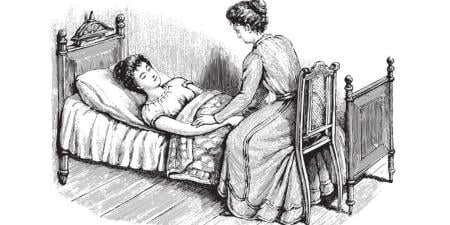"Why is it that the important problems of older persons are often not the ones that we know how to help?" [1]
By 2020, 60 percent of hospital patients will be 65 and older [2], due in part to the technological and medical advances that are allowing people to live longer lives. As physicians encounter this growing number of older patients, many of whom have multiple comorbid conditions, they will need to know how to look beyond the patient's physical health to the social environment and relationships that contribute to overall well-being and quality of life. How can physicians, accustomed to improving their patients' quality of lives through medicine, take on responsibility for the circumstances that exist beyond the hospital and clinic doors?
Moreover, respecting a patient's autonomy—a cornerstone of professional duty when working with all adults—is not so easily accomplished when managing care for the elderly. These topics are the focus of this month's Virtual Mentor.
Medical training traditionally emphasizes patient autonomy—that is, adhering to the wishes of the patient; physicians are taught that patients are the ultimate decision makers when it comes to their own care. Following this principle can be difficult when patients do not have full decision-making capacity or when they simply wish to defer to their family members' decisions. In such situations, physicians may become frustrated by struggles within the family and the time-consuming processes of mediating and determining what their patients truly "would want." In what ways can physicians continue to respect their patients' autonomy when family members and others become involved in the patient-physician relationship? The challenges of family-centered decision making serves as the basis for one of this month's clinical cases.
"Most doctors treat disease, and figure that the rest will take care of itself. And if it doesn't—if a patient is becoming infirm and heading toward a nursing home—well, that isn't really a medical problem, is it?" [3]
Most physicians are comfortable with treating illnesses that compromise their patients' quality of life. Prescribing an oxygen tank for a patient with COPD (chronic obstructive pulmonary disease), for example, or a medication for depression are fairly straightforward. But as patients grow older and develop advanced medical conditions, frailty, cognitive dysfunction, impaired vision or hearing, social isolation, and safety at home can become serious concerns. How can physicians justify limiting a patient's independence in the interest of his or her "own safety," when independence and the ability to continue living at home are essential for most older patients' quality of life? This question is further explored in our other two clinical cases and in the health law article on physician duty to report older, impaired drivers.
Clinic visits are the optimal time to discuss with elderly patients and their families the social issues mentioned above, as well as patients' values and care preferences, including advanced directives, living wills, and resuscitation status. In the "real world," however, where 20 minutes are available to discuss blood pressure, blood sugar control, medication reconciliation, chronic back pain, and vague memory difficulties, there is rarely time to have this conversation. Because of lack of time—and training —physicians are seldom able to give adequate attention to the social factors that may affect an elderly patient's day-to-day life and ability to stay out of the hospital.
A fine line exists between physicians' responsibilities and society's obligations to respect the autonomy and preserve the quality of life of elderly patients. This line is becoming less well defined as we discover that the successful management of an elderly patient's medical problems is often rooted in optimizing his or her social situation. Let's say, for example, that management of a patient's depression enables her to comply with her heart failure treatment which, in turn, minimizes hospitalizations. And let's say the management of her depression is dependent, in part, on her access to transportation to dine at the senior center with friends and to keep physician appointments. How much of the physician's limited clinic time should be spent on securing access to transportation and investigating other obstacles to social integration? The medicine and society section grapples with the physician's responsibility to help preserve a patient's quality of life.
Thomas, Leipzig, and Smith summarize the broad responsibilities of managing well-being for the elderly. They write that care for older patients requires
coordination with family; consulting physicians; and nonphysician health care providers, such as social workers, pharmacists, and therapists.... No reimbursement is provided for the numerous telephone calls; family meetings; the office time and space needed to get a patient undressed and on an examination table; or 'geriatric procedures' such as...evaluating cognitive function...The time it takes physicians to access home care personnel, social workers, case managers, and other community resources...are often not reimbursed by Medicare [4].
Can medicine afford to shoulder the responsibility of managing patients' sociomedical well-being when the cost of medical care alone is so high and social issues rarely have a definite endpoint? This month's policy forum looks at the high cost of health care, specifically the inadequacy of funding for long-term care. In a similar vein, the journal discussion examines nonpharmacological treatment and patient-centered techniques that can minimize the effects of behavioral and psychosocial symptoms of dementia—but at costs that are not typically reimbursed. Finally, the op-ed considers reforms to Medicare that might restore that program's fiscal soundness as the baby boomers become eligible for its benefits.
While 39 percent of general internist clinic visits are by elderly patients, physicians trained in internal medicine subspecialties see an even higher percentage of elderly patients [5]. In a care system this fragmented, all medical students and residents should have a general idea of the unique aspects of providing geriatric care, a point emphasized in the medical education section.
Physicians are frequently the ultimate advocates for their patients' autonomy, and, inasmuch as social situations play a larger part in inhibiting (or allowing for) successful medical care, physicians must learn how to preserve quality of life even as they prolong it. I hope this issue of Virtual Mentor will provide not only practical suggestions for approaching some of the difficult situations and conversations mentioned above, but also insight into the growing concerns of maintaining quality of life and autonomy through old age.
References
-
Wei JY, Sheehan MN, eds. Geriatric Medicine: A Case-Based Manual. Oxford, UK: Oxford University Press; 1997.
- Bragg EJ, Warshaw GA, Arenson C, Ho ML, Brewer DE. A national survey of family medicine residency education in geriatric medicine: comparing findings in 2004 to 2001. Fam Med. 2006;38(4):258-264.
- Gawande A. The way we age now: medicine has increased the ranks of the elderly. Can it make old age any easier? . New Yorker. 2007;83(10):50-59.
- Thomas DC, Leipzig RM, Smith LG, Dunn K, Sullivan G, Callahan E. Improving geriatrics training in internal medicine residency programs: best practices and sustainable solutions. Ann Intern Med. 2003;139(7):628-634.
-
Warshaw GA, Bragg EJ, Thomas DC, Ho ML, Brewer DE; Association of Directors of Geriatric Academic Programs. Are internal medicine residency programs adequately preparing physicians to care for the baby boomers? A national survey from the Association of Directors of Geriatric Academic Programs Status of Geriatrics Workforce Study. J Am Geriatr Soc. 2006;54(10):1603-1609.



